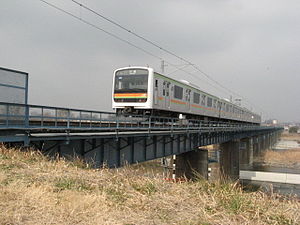Hachikō Line
This article needs additional citations for verification. (December 2009) |
| Hachikō Line | |||
|---|---|---|---|
 209 series EMU crossing the Tama River, February 2007 | |||
| Overview | |||
| Native name | 八高線 | ||
| Locale | Tokyo Metropolis, Saitama Prefecture, Gunma Prefecture | ||
| Termini | |||
| Stations | 23 | ||
| Service | |||
| Type | Heavy rail | ||
| Operator(s) | JR East | ||
| Rolling stock | 205-3000 series, 209-3000 series, 209-3100 series, E233 series, KiHa 110 series | ||
| History | |||
| Opened | 1931 | ||
| Technical | |||
| Line length | 92.0 km (57.2 mi) | ||
| Track gauge | 1,067 mm (3 ft 6 in) | ||
| |||
The Hachikō Line (八高線, Hachikō-sen) is a 92.0 km regional railway line owned and operated by East Japan Railway Company (JR East). It is located within Tokyo, Saitama, and Gunma Prefectures in Japan. It connects Hachiōji Station in Hachiōji, Tokyo with Kuragano Station in Takasaki, Gunma Prefecture.
Services
Komagawa Station in Hidaka, Saitama is the boundary point between two distinct sections. The southern section from Hachiōji to Komagawa is electrified at 1,500 V DC. Some trains terminate at Komagawa, while others continue over the Kawagoe Line to Kawagoe Station. A few trains leave the Hachikō Line at Haijima Station, entering the Ōme Line and terminating at Tokyo Station.
The non-electrified northern section connects Komagawa with Kuragano. All trains continue on the Takasaki Line to Takasaki, where transfer to the Jōetsu Shinkansen is available. There are no through services connecting the southern and northern halves of the line.
Japan Freight Railway Company (JR Freight) also operates trains on the Hachikō Line.[citation needed]
The Hachikō Line takes the first kanji of its name from the first character of Hachiōji (八王子) and the second kanji from the first character of Takasaki (高崎).
Stations
- All trains stop at every station.
- Stations marked "o" or "^" allow passing; stations marked"|" do not. Stations marked "∥" are double-tracked.
Rolling stock
- 205-3000 series 4-car EMUs x 5 (Kawagoe Line/Hachikō Line services)
- 209-3000 series 4-car EMUs x 4 (Kawagoe Line/Hachikō Line services since March 1996)[1]
- 209-3100 series 4-car EMUs x 2 (Kawagoe Line/Hachikō Line services since 17 April 2005)[1]
- E233 series EMUs (Chūō Line (Rapid) through services between Komagawa and Haijima, from 17 March 2007)
- KiHa 110 series DMUs (formed as 1- to 3-car trains for services north of Komagawa)
Rolling stock previously used
- KiHa 35 DMUs (until March 1996)
- 103-3000 series EMUs (from March 1985 until October 2005)[1]
- 103-3500 series EMU (from March 1996 until March 2005)[1]
- 201 series EMUs (Chūō Line (Rapid) through services between Komagawa and Haijima, until March 2008)
-
KiHa 35 DMUs passing at Yorii Station, August 1992
-
Komagawa Station with a variety of rolling stock visible, August 2003
History
The first sections of the line opened from Kuragano to Kodama in July 1931 and from Hachioji to Higashi-Hanno in December 1931.[2] The section between Kodama and Yorii opened in January 1933, and the section between Higashi-Hanno and Ogose in April 1933.[2] The section between Ogose and Ogawamachi opened in March 1934, and the last section between Ogawamachi and Yorii opened in October 1934.[2]
CTC signalling was commissioned in 1985.[citation needed] The Hachioji - Komagawa section was electrified at 1,500 V DC in 1996. Wanman driver only operation commenced on the non-electrified section between Komagawa and Takasaki on 16 March 1996, using KiHa 110 series DMUs.[3]
Former connecting lines
A 6 km line was opened from Tansho Station to the Seibu chemical plant in 1942. A passenger service was operated from 1947 until 1973, and the line closed in 1986.[citation needed]
Accidents
In 1945 a head-on collision at the Tamagawa bridge resulted in 105 fatalities.[citation needed]
The Hachiko Line derailment in 1947 is Japan's worst rail accident since World War II in terms of fatalities.
References
This article incorporates material from the corresponding article in the Japanese Wikipedia.
- ^ a b c d "川越線に209系3100代を投入 103系を置換え". Railway Journal. 39 (465). Japan: Tetsudō Journal: p.106. July 2005.
{{cite journal}}:|page=has extra text (help); Unknown parameter|trans_title=ignored (|trans-title=suggested) (help) - ^ a b c 首都圏鉄道完全ガイド 主要JR路線編. Japan: Futabasha. 6 December 2013. p. 75-86. ISBN 978-4-575-45414-7.
{{cite book}}: Unknown parameter|trans_title=ignored (|trans-title=suggested) (help); templatestyles stripmarker in|title=at position 1 (help) - ^ JR気動車客車編成表 '04年版. Japan: JRR. 1 July 2004. p. 197. ISBN 4-88283-125-2.
{{cite book}}: Unknown parameter|trans_title=ignored (|trans-title=suggested) (help); templatestyles stripmarker in|title=at position 1 (help)








